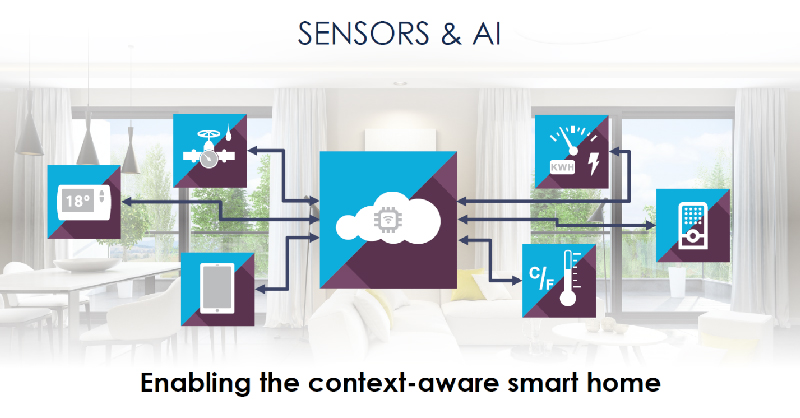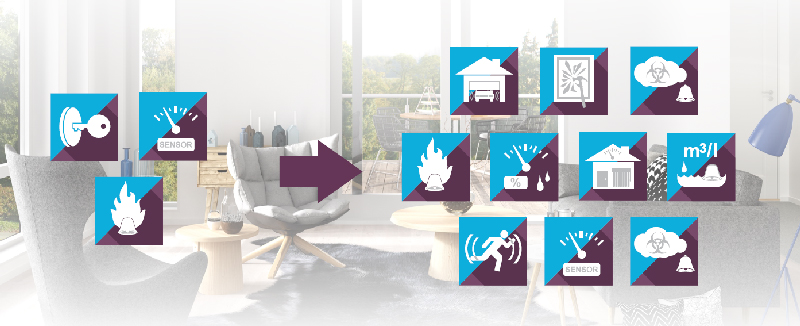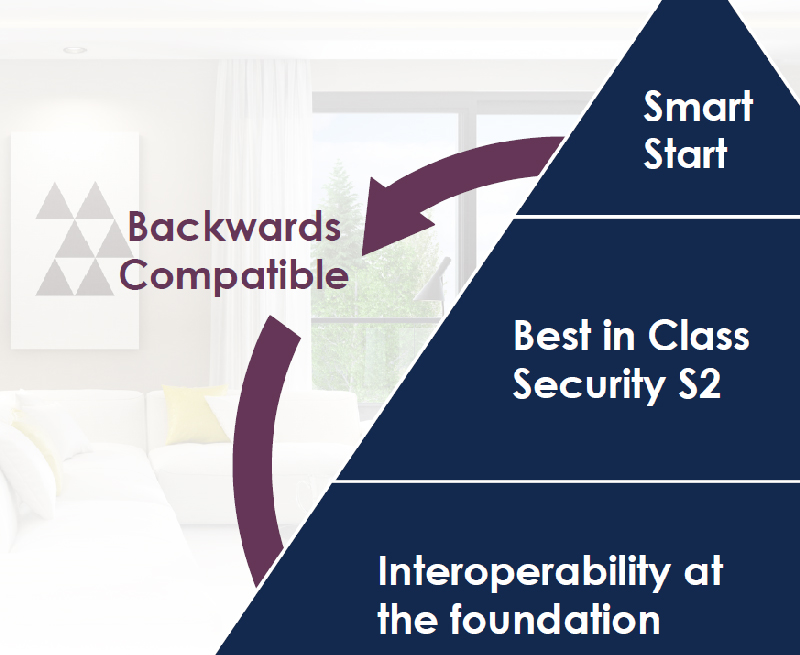IoT advancements enable AI for the context-aware smart home
The smart home has been growing over the last decade, both in the number of devices on the market and the number of homes with devices. Recent statistics from Futuresource Consulting, reveal that smart home devices will achieve a retail value of $6bn worldwide this year, with revenues expected to triple by 2021.
By: Johan Pedersen, Product Marketing Manager Z-Wave/IoT, Silicon Labs
This rapid growth directly correlates to the popularity of voice assistants such as Amazon Alexa, Apple’s Siri, and Google Home. These assistants are driving heightened consumer interest in the smart home as they are an easy and intuitive way to control devices, but they have limited built-in intelligence.
As smart home product development advances, it becomes even more necessary for engineers to create devices that can adapt to consumers and the context in which they spend their time at home. To realise new opportunities for smart home devices, manufacturers must overcome complex technical challenges, and they must do so while considering device cost and time-to-market.
We are closer than ever to a context-aware smart home, where applications will respond and adapt automatically to changes in the home and environment through sensing technology that can detect user proximity or environmental factors.
Context-aware applications will rely on sensors connected wirelessly into a system to collect data about the home, the occupants, and other conditions, and then use that data in algorithms and artificial intelligence (AI) to improve the quality of the user’s interaction with the devices.
As seen in Figure 1 below, this level of intelligent data usage can create a smart home environment that will allow users to control areas around them with minimal voice commands and enable the home to adjust its devices more automatically.

New technologies use occupant presence, location, and other environmental information such as temperature or humidity to deliver context-enriched applications and services that anticipate a user’s needs and can be situation-aware to enact activation of lighting, thermostat, and other smart home devices.
These context-aware smart home applications driven by AI and smart sensor devices are only possible due to chip-level technology enhancements that enable greater battery life, longer range, intelligent computations at the edge, and higher levels of security.
A new class of sensor
Contextual data in the smart home comes from devices in the home such as occupancy sensors, wearable devices, temperature and security sensors, as well as environmental sensors gathering data from outside the home.
Today’s smart home focuses on control and management, allowing users and homeowners to execute commands to turn on lights, adjust the temperature, and see who’s at home.
These capabilities are based on various wireless protocols connecting the smart home devices, which include Wi-Fi, Bluetooth, Thread, Zigbee, and Z-Wave. Each of these communication standards provides a set of functionalities, and protocols chosen by the device manufacturer can affect how a device will operate, and its ability to operate intelligently, in a smart home environment.
Each of these wireless technologies has pros and cons. Here are a few potential limitations: high battery usage of wireless devices, short range requiring extenders, and lower processing power to mitigate battery drain. These limitations could prevent the smart home from being truly intelligent. Remote parts of the home and yard might be out of reach, and battery-operated devices, such as wireless sensors, might require frequent replacement.
Now imagine a wireless sensor that lasts ten years on a single coin-cell battery; it could be embedded into new places in the home to provide sensor data to a machine learning engine that can understand context to bring adaptive automation to the home by combining data about the weather, appliances, and the time of day to program and deliver smart applications.
These advancements can enable homeowners to get insurance discounts, lower energy bills, and enhance their family’s safety.
For example, as seen in Figure 2 below, the next-generation Z-Wave 700 Series chipset will enable new features such as longer range, lower power for a decade of life on a coin-cell battery, and improved processing power for more intelligence at the edge with fast, energy efficient computation.

These features could open opportunities for new classes of sensors that haven’t yet been possible. The 700 Series Z-Wave platform’s energy efficient, long range wireless communication will allow smart home sensors to go beyond the current limits, enabling smart homes to extend to the yard and to the end of the driveway, and seamlessly cover multiple stories in a home. The platform’s extremely low power consumption will enable new small form factor Z-Wave sensors, which can be embedded into new places such as into furniture.
Context-aware applications require higher processing power and more memory to enable decisions and complex applications to be handled at the edge with quick computation and a completely secure inclusion in under a second, and without the need for a co-processor.
The ability for devices to last longer on a small battery is specifically important for intelligent smart homes, where sensors can be embedded into the home’s dry wall, in hard-to-reach spots prone to flooding or leaks, or even out in the mailbox.
The information from these sensors can be fed into a virtual assistant to give it the power to understand the context of the home. The benefits of this approach are twofold: more accurate, data-driven capabilities to predict safety or security hazards and new smart home use cases.
With a sensor in the mailbox, a future smart home could flash a lamp light or send a push notification that the mail or a package has arrived. Unusual environmental conditions in the home could be tracked to prevent hazards; for example, a sensor in the basement could track changes in humidity over time that might indicate a water leak or mold.
Interoperability at the foundation
The context-aware smart home relies on multiple devices gathering data, wirelessly communicating it to another device and then acting after receipt of that data. For example, WiFi was introduced to provide a continuous flow of data that can pass through walls and connect computers to broadband without cables.
Bluetooth was created for short range data transfers, such as between a headset and a mobile phone. Both technologies arrived with caveats that weren't critical before the IoT. For example, traditional WiFi technology uses too much energy to be practical for battery-operated devices, and Bluetooth was designed for point-to-point connections between two objects in close proximity, and not a building full of wireless devices.
Subsequent technologies that evolved using the 2.4GHz band, such as Zigbee, introduced smart products that spoke specialized wireless 'dialects' optimised for various applications such as lighting, smart home, and smart energy. Other technologies, like Z-Wave, opted to create an ecosystem, emphasising cross-brand interoperability as a primary goal.
Z-Wave, which uses the less-crowded 900MHz, opted for an open set of descriptors and rules that allows many objects of different types from any manufacturer to speak a common language. As a result of its decision to mandate interoperability as well as security, Z-Wave has so far been able to develop the largest ecosystem of smart home products.
Device connectivity may not be at the forefront of the consumer’s mind when they buy smart home products, as they’re focused on each single device’s functionality. We’re in the first curve of smart home adoption; as DIY moves forward and homeowners add more devices to create a smart home ecosystem instead of a few single devices, interoperability will become paramount.
The light bulb, smart lock, and thermostat might not talk to each other now and might have different apps, but a smart home cannot grow without inter-device communication. The only way to make these intelligent interactions happen with various devices and guarantee that they are done with mandated security is through a common communication language.
Securing the context-aware smart home
The IoT introduces a wide range of new security risks and challenges to connected devices, their platforms and operating systems, their communications, and even the systems to which they're connected.
This becomes even more personal and an increasing concern for consumers when it involves sensors that know the location of occupants and family members.Given the reach of the new smart home device capabilities, cybersecurity is becoming more critical in the IoT, and companies across many industries are rushing to meet the need for heightened security.
Among the various smart home protocols, Z-Wave is long established; as a result, it has invested the most focus on cyber protection, having introduced a security framework called Z-Wave Security 2 (S2). Prior to S2, Z-Wave was built on application layers.
It was up to the manufacturers to implement the security, and not all manufacturers had the same level of expertise or appreciation for the importance of security.
Now with S2, all transmissions are secure because hackers cannot circumvent the security application layer. The heavy lifting of security is built directly into the protocol, and manufacturers can focus on developing more intelligent, interactive smart home products - see Figure 3 below.

New and emerging IoT technologies are driving the convergence of wireless connectivity and intelligence at the edge. Wireless sensors with a battery life of ten years or more can now be embedded in hard-to-reach places in smart homes, enabling IoT systems to respond automatically to changing environmental conditions and user preferences.
Today, the average US home already includes six to ten smart devices. Advancements in the Z-Wave platform will enable ubiquitous and economical sensing throughout the smart home, making it possible and practical for deployments of dozens or even hundreds of Z-Wave devices per home, all while maintaining interoperability with the current installed base of millions of Z-Wave devices and gateways.











